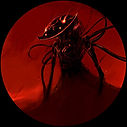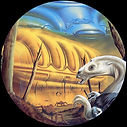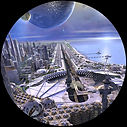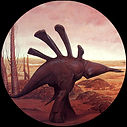
















Life in the solar system
The Moon’s surface is inhospitable to life of any sort. Diurnal temperatures range from about 100 K (−173 °C, or −279 °F) to about 400 K (127 °C, or 261 °F). In the absence of either an atmosphere or a magnetic field, ultraviolet light and charged particles from the Sun penetrate unimpeded to the lunar surface. In less than an hour, they deliver a dose lethal to the most radiation-resistant bacteria known. The subsurface environment of the Moon is not nearly so inclement. Ultraviolet light and solar protons do not penetrate more than 1 meter (3.3 feet) below the surface, and the temperature is maintained at a relatively constant value of about 230 K (−43 °C, or −45 °F). Nevertheless, the absence of any surface fluid, atmosphere, or liquid to cycle matter and energy makes prospects for life dim.
The environment of Mercury is rather like that of the Moon. Its surface temperatures range from about 100 K to about 620 K (347 °C, or 657 °F), but, about 1 meter below the surface, the temperature is constant at roughly room temperature. However, the absence of any significant atmosphere, the unlikelihood of bodies of liquid, and the intense solar radiation make the prospect for life on Mercury remote.
Evidence for life on Mars has been claimed for more than a century. The first such argument was posed by a French astronomer, Étienne L. Trouvelot, in 1884:
Judging from the changes that I have seen to occur from year to year in these spots, one could believe that these changing grayish areas are due to Martian vegetation undergoing seasonal changes.
The seasonal changes on Mars have been reliably observed, not only visually but also photometrically. There is a conspicuous springtime increase in the contrast between the bright and dark areas of Mars. Color changes with season have also been reported. Space probes have found no vegetation on Mars, but seasonally variable dust storms provide a convincing explanation of the color changes.
Mars as seen by Hubble Space Telescope compared with an 1894 map of MarsMars as seen by the Hubble Space Telescope (left) compared with a map of Mars based on French astronomer Eugène Antoniadi's observations in 1894. Antoniadi later concluded that what he thought were Martian canals are an optical illusion.
Historically, life on Mars was argued for on the basis of the “canals.” This apparent set of thin straight lines across the Martian bright areas extends for hundreds, even thousands, of kilometers and changes seasonally. First systematically observed in 1887 by Italian astronomer Giovanni V. Schiaparelli, the lines were further catalogued and popularized about the turn of the 20th century by American astronomer Percival Lowell. From the unerring straightness of the lines, Lowell argued they could not be natural in origin. Instead he interpreted them as artificial constructs built by intelligent Martians. Lowell suggested they might be channels that carry water from the melting polar caps to the parched equatorial cities. However, many other astronomers were not able to see the canals, and the canals are now believed to be an optical illusion. Approximately rectilinear features do exist on the Martian surface, but these are natural features such as crater chains, terrain contour boundaries, faults, mountain chains, and ridges analogous to the suboceanic ridge features of Earth.
surface of Mars from Viking 1 landerMartian surface of rocks and fine-grained material, photographed in 1976 by the Viking 1 spacecraft.
In July and August 1976 two U.S. probes, Viking 1 and 2, successfully landed on Mars with equipment designed to detect the presence or remains of organic material. Analyses of atmospheric and soil samples yielded conclusive results; the data were interpreted as negative. At least in the vicinity of these probes, no evidence for life exists. In 1996 analysis of the Allan Hills Martian meteorite (ALH84001) yielded structures and sedimentary magnetite that some have interpreted as direct evidence for extremely small microbial life on Mars. However, most scientists are very skeptical that the Allan Hills meteorite actually contains traces of past Martian life. The culprits are more likely to be tiny carbonate crystals and abiogenic magnetite. The search for past and current life on Mars continues.
The average surface temperature of Venus is approximately 750 K (477 °C, or 891 °F). Even at the poles or on the tops of the highest Venusian mountains, surface temperatures do not fall below 400 K (127 °C, or 261 °F). The temperatures on Venus are too hot for Earth-style life. However, carbon dioxide, sunlight, and water (according to the results of the Venera space vehicles) are found in the clouds of Venus. These three are the prerequisites for photosynthesis. Molecular nitrogen also is expected at the cloud level, and some minerals are likely convectively raised to the cloud level from surface dust. The cloud pressures are about the same as those on the surface of Earth, and the temperatures in the lower clouds also are quite Earth-like. Although highly acidic by virtue of their sulfur, the lower clouds of Venus are the most Earth-like extraterrestrial environment known. No organisms on Earth lead a completely airborne existence, so most scientists dispute the possibility that organisms exist buoyed in the clouds of Venus.
Jovian planets
Jupiter's Great Red SpotJupiter's Great Red Spot and its surroundings, photographed by Voyager 1, February 25, 1979. Included are the white ovals, observed since the 1930s, and immense areas of turbulence to the left of the Great Red Spot.
The atmosphere of Jupiter is composed of hydrogen, helium, methane, ammonia, some neon, and water vapor. These are exactly the gases used in experiments that simulate the early Earth. Laboratory and computer experiments have been performed on the application of energy to simulated Jovian atmospheres. Immediate gas-phase products include significant quantities of hydrogen cyanide and acetylene. More-complex organic molecules, including aromatic hydrocarbons, are formed in lower yields. The clouds of Jupiter are vividly colored, and their hue may be attributable to organic compounds. An apparent absorption feature near 260 nanometers in Jupiter’s ultraviolet spectrum may be due to aromatic hydrocarbons or even due to nucleotide bases. Jupiter may be a vast planetary brew that has operated for 4.5 billion years as a laboratory of organic chemistry.
SaturnSaturn and its spectacular rings, in a natural-color composite of 126 images taken by the Cassini spacecraft on October 6, 2004. The view is directed toward Saturn's southern hemisphere, which is tipped toward the Sun. Shadows cast by the rings are visible against the bluish northern hemisphere, while the planet's shadow is projected on the rings to the left.
The other Jovian planets, Saturn, Uranus, and Neptune, resemble Jupiter, although less is known about them. Their cloud-top temperatures progressively decrease with distance from the Sun. Microwave studies of Saturn indicate that the atmospheric temperature increases with depth below the clouds. A similar situation is expected to exist on Jupiter, Uranus, and Neptune. These planets of the solar system are associated with many natural satellites. Some, such as Titan, a satellite of Saturn, and Io, a satellite of Jupiter, have atmospheres. Despite the relative suitability for life’s preconditions, no evidence is known for life on the outer planets or their satellites.
Europa, other Jovian moons, comets, and asteroids
EuropaCrescent view of Europa, one of Jupiter's four large, Galilean moons, in a composite of images made by the Galileo spacecraft in 1995 and 1998. Colors have been exaggerated in processing to reveal subtle differences in surface materials. The reddish lines in the moon's icy crust are cracks and ridges, some of them thousands of kilometers long, while the reddish mottling indicates areas of disrupted ice, where large ice blocks have shifted. The red material may be salt minerals deposited by liquid water that emerged from below the surface. The relatively few craters indicate that the icy crust has been relatively warm and mobile for at least a good part of Europa's early history.
Europa, the fourth largest satellite of Jupiter, may be the best candidate for extraterrestrial life in the solar system. The Galileo orbiter revealed a crust of water ice and a complex surface on this moon. Optical imaging, thermographic temperature probes, and magnetic field measurements support the strong inference that a liquid saltwater ocean surges beneath the frozen crust. A wisp of an oxygen atmosphere has also been detected by spectrographic techniques. Furthermore, since organic molecules including methane and nitrogen-rich gases such as ammonia abound on Jupiter and some of its other moons, such “prebiotic chemicals” are highly likely to be present on Europa. The Galileo flyby also detected abundant sulfuric acid, a potential chemical power source, on the surface of Europa. (Such discoveries in the Jovian planets inspire further investigation of the limits to diversity of life on Earth. Lakes such as Vostok in Antarctica reside under more than 3 km [2 miles] of ice. Studies of bacteria in these lakes and of water seeps within cavities in granitic and carbonate rocks provide models for the viability of possible Earth-like life-forms on Europa and other Jovian moons.)
Io is the most volcanically active place in the solar system, and Ganymede and Callisto may also have water ice under their surfaces. The immense tidal influence of Jupiter regularly pumps energy into these planetary systems. Now that it has become clear that chemoautotrophic life-forms do not require sunlight as sources of energy, some scientists argue that a shift of focus from Mars and the other inner planets is in order. The outer planets’ satellites, especially Europa and Saturn’s Titan, promise new insights into the search for extraterrestrial life in the solar system. In 2008, for example, the Cassini spacecraft reported several hundred lakes and seas of organic materials on Titan, dozens of which contain more liquid hydrocarbon (such as methane and ethane) than all of Earth’s oil and gas reserves combined.
Unidentified Flying Objects: What We Know
Tens of thousands of comets, as well as some thousands of asteroids and asteroidal fragments revolving about the Sun between the orbits of Mars and Jupiter, contain organic molecules. The asteroids are the presumed sources of the carbonaceous chondrites’ organic matter. Pluto has a predominantly nitrogen atmosphere covering a surface of frozen nitrogen, carbon dioxide, and methane. The intense cold and paucity of solar radiation on Pluto and the lack of atmosphere and liquid waters on the asteroids argue against the likelihood of finding life on these bodies.

Life beyond the solar system
For thousands of years humans have wondered whether they were alone in the universe or whether other worlds populated by more or less humanlike creatures might exist. In ancient times and throughout the Middle Ages, the common view was that Earth was the only “world” in the universe. Many mythologies populated the sky with divine beings, certainly a kind of extraterrestrial life. Some philosophers held that life was not unique to Earth. Metrodorus, an Epicurean in the 3rd and 4th centuries bce, argued that,Since the Renaissance, fashionable belief has fluctuated. Practically all informed opinion in the late 18th century held that each planet was populated by intelligent beings. However, except for those who followed Percival Lowell, the prevailing informed opinion in the early 20th century held that chances for extraterrestrial intelligent life were insignificant. The subject of extraterrestrial intelligent life is for many people a touchstone of their beliefs and desires. Some urgently desire evidence for extraterrestrial intelligence, and others equally fervently deny the possibility of its existence. The subject should be approached in as unbiased a frame of mind as possible. The probability of advanced technical civilizations in the Milky Way Galaxy depends on many controversial issues.
The Drake equation and extrasolar life
American astrophysicist Frank D. Drake devised a simple approach that illuminates the uncertainties involved in determining whether extraterrestrial intelligence is possible. The number of extant technical civilizations in the Milky Way Galaxy is estimated by the following equation (the so-called Drake equation, or Green Bank formula): N = R*fpneflfifcL where R* is the average rate of star formation over the lifetime of the Milky Way Galaxy, fp is the fraction of stars with planetary systems, ne is the mean number of planets per star that are ecologically suitable for the origin and evolution of life, fl is the fraction of such planets on which life arises, fi is the fraction of such planets on which intelligent life evolves, fc is the fraction of such planets on which a technical civilization develops, and L is the mean lifetime of a technical civilization. A consideration of the factors involved in the choice of numerical values for each parameter follows. These estimates are little better than informed guesses; no great reliability should be pretended for them.
HD 209458bArtist's conception of the extrasolar planet HD 209458b, some 150 light-years from Earth.
There are about 200 billion stars in the Milky Way Galaxy. The age of the Milky Way Galaxy is about 10 billion years. A value of R* = 10 stars per year is probably fairly reliable. While most contemporary theories of star formation imply that the origin of planets accompanies the origin of stars, such theories are not developed well enough to merit much confidence. More than 250 extrasolar planets have been confirmed. They have been observed via several different means: by “wobble,” which detects the changing wavelength of a star’s light as the star gets closer and then farther away from Earth as a massive planet tugs it from the center of the system; by transit, which detects the dimming of a star as a planet crosses between it and Earth, much like a solar eclipse; and by infrared observation, which observes a planet directly.
Owing to limitations of current detection methods, most of the planets discovered so far have masses at least as great as the solar system’s largest planets, Jupiter and Saturn. Most of these planets are also very close to their stars, much closer than Earth is to the Sun, so life systems similar to Earth’s could not exist on them. This difference has led scientists to consider new models for planetary formation. For example, Gliese 876, a red dwarf star one-third the mass of the Sun and 15 light-years away in Aquarius, has three planets: a gas giant half the mass of Jupiter that orbits Gliese 876 every 30 Earth days, another twice the mass of Jupiter that orbits exactly once for every two orbits of its neighbor, and a third six times the mass of Earth that orbits every 2 Earth days. HD 168443, lying 123 light-years away in Serpens, has one planet 8 times Jupiter’s mass and another 18 times the mass of Jupiter, which is beyond the scale that had been considered possible for a planet; this giant may be a brown dwarf. Several planets even smaller than Saturn have been found. Gliese 581, at 20 light-years away, has three planets, one of which is only five times the mass of Earth. NASA’s Kepler mission, launched in 2009, used space-based telescopes to observe Sun-like stars that host Earth-sized planets and discovered thousands of extrasolar planets.
Because the wobble method can detect only a planet that has been observed for a significant portion of its orbit, finding a planet like Jupiter with an orbital period of 12 Earth years requires several years of observations. Nevertheless, some planetary systems similar to the solar system have been found. HD 190360A, at 52 light-years away, is very similar to the Sun and has a detectable planet similar in size and orbital distance to Jupiter. Systems like HD 190360A could also have smaller planets arranged like those in the solar system. The existence of large planets around so many nearby stars demonstrates that a significant fraction of stars do indeed have planets in orbit around them.
Another indication that planetary formation is a general process throughout the universe is the satellite systems of the major planets of the solar system. Jupiter with 79 satellites, Saturn with 82, and Uranus with 27 resemble miniature solar systems. Considering the wide range of temperatures that seem to be compatible with life, it can be tentatively concluded that fpne is about 1. However, since liquid water is considered to be crucial to life’s origin and evolution, fpne probably has a significantly smaller value.
Because of the short time it took for life to arise on Earth, as implied by the fossil record, and because of the ease with which relevant organic molecules are produced in experiments that simulate the early Earth, the likelihood of life’s arising during a period of billions of years may be high. Some scientists believe that the appropriate value of fl, the fraction of planets with life, is about 1. For the quantities of fi, the fraction of planets with intelligent life, the parameters are even more uncertain. The evolutionary path leading to mammals depends on a great many specific circumstances and historical accidents; it is therefore highly unlikely that such a path will ever repeat. However, intelligence clearly has a great selective advantage and is not necessarily restricted to the single evolutionary path that occurred on Earth.
Similar arguments are made for fc, the fraction of technical civilizations. Intelligence and technical civilization are clearly not equivalent. For example, dolphins appear to be intelligent, but their lack of manipulative organs limits their technology. Both intelligence and technical civilization evolved about halfway through the lifetime of Earth and the Sun. Some, but by no means all, evolutionary biologists would conclude that 1/100 is a conservative estimate for the product fifc.
Still more uncertain is the value of the final parameter, L, the lifetime of a technical civilization. A technical civilization here is defined as one capable of interstellar radio communication. Thus, human technical civilization is only a few decades old. Technical civilizations may tend, through the use of weapons of mass destruction, to destroy themselves shortly after they come into being. If L is then taken to be 10 years, multiplication of all the factors assumed above leads to the conclusion that only one technical civilization exists in the Milky Way Galaxy—our own. But if technical civilizations do not produce massively destructive weapons or use them to annihilate themselves, then the lifetimes of technical civilizations may be very long. In that case, the number of technical civilizations in the Milky Way Galaxy may be immense. If even 1 percent of developing civilizations make peace with themselves, then about 1,000,000 technical civilizations may be extant in the Milky Way Galaxy. If such civilizations were randomly distributed in space, the nearest would be several hundred light-years from Earth. These conclusions are very uncertain.
Searching for technical civilizations
How would technical civilizations enter into communication with one another? Independent of the value of L, the Drake formula cited above implies that about one technical civilization arises every 10,000 years in the Milky Way Galaxy. Accordingly, it would be extraordinarily unlikely for humans to find a technical civilization as backward as Earth’s. The rate of technical advance on Earth in the past few hundred years makes it clear that no serious and reliable projection of future scientific and technical advances can be made. Advanced civilizations are expected to have techniques and sciences unknown to 21st-century people. Nevertheless, humanity is already capable of communication by radio over interstellar distances. If Earth’s largest radio telescope, the 500-meter- (1,600-foot-) diameter dish at the Five-hundred-meter Aperture Spherical Telescope in China and its receivers, is employed and if identical equipment is employed on some transmitting planet, how far apart could the transmitting and receiving planets be for intelligible signals to be passed? The rather astonishing answer is about 2,500 light-years. Within a volume centered on Earth with a radius of 2,500 light-years, there are more than 150,000,000 stars.
Problems would definitely surface in the establishment of such radio communication. The frequency, target star, longevity, and character of the message would all have to be selected by the transmitting planet so that the receiving planet would be able to deduce them without too much effort. None of these problems seems insuperable. One choice might be to listen to stars of approximately solar spectral type. Certain natural radio frequencies, such as the 1,420-megahertz (21-cm) line of neutral hydrogen, might also be used. In the absence of any symbols or language in common, messages that use the neutral hydrogen line might be the most appropriate for discerning intelligent origin and intellectual content from life-forms that do not share human evolutionary history. Very few anthropocentric assumptions would be needed.
Because Earth’s technologies are relatively new, it makes little sense to transmit messages to hypothetical planets of other stars. But it does make sense to listen for radio transmissions from planets of other stars. Other communication techniques include laser transmission and interstellar spaceflight, but these may not be feasible. American engineers Christopher Rose and Gregory Wright have argued that sending a physical artifact is a preferable communication technique because radio waves tend to disperse, whereas physical artifacts retain their information in compact form and are more likely to be readable when they arrive at their destination. However, such “messages in a bottle” would travel 1,000 times slower than light. If the measure of effectiveness is the amount of information communicated across a broad area per unit cost, then radio transmission is the method of choice.
A scientific search for intelligent extraterrestrial life that could communicate beyond its own celestial home was first called for in 1959 by Italian physicist Giuseppe Cocconi and American physicist Philip Morrison. Using the radio telescope at Green Bank, West Virginia, in 1960, Drake mounted the first (very brief) search, Project Ozma, which was oriented to two nearby stars, Epsilon Eridani and Tau Ceti. On the basis of the Drake equation, it would be very unlikely that success would greet an effort aimed at two stars only 12 light-years away. Not surprisingly, Project Ozma was unsuccessful. Related programs organized on a larger scale were mounted with great enthusiasm in the 1960s in the U.S.S.R.
After Project Ozma ended, various government and private projects continued the search for extraterrestrial intelligence (SETI). The Planetary Society, founded in 1980 by American astronomer Carl Sagan, planetary scientist Bruce Murray, and aerospace engineer Louis Friedman, has as one of its aims the bringing together of professionals and amateurs in support of SETI. Funding by American movie director Steven Spielberg permitted the society to start the first privately funded SETI project, the Megachannel Extraterrestrial Assay, in 1982.
SETI@homeThe SETI@home screen saver.
Several searches for extraterrestrial signals that might indicate attempts of extraterrestrial life to communicate with itself are under way. Both radio and optical light transmissions are sought, with instruments receiving cosmic signals in both the Northern and Southern hemispheres. The involvement of amateurs is encouraged. Even the pooling of resources of home computers to analyze the prodigious amounts of data received from outer space helps in the effort. With the communication advantages of the World Wide Web, astronomers from all parts of the globe may aid in the effort. An array of radio dishes near Buenos Aires searches millions of channels for radio transmissions in the southern sky. Professionals and their amateur colleagues at Harvard University search for signals from the visible regions of the electromagnetic spectrum in the Optical SETI project at the Oak Ridge Observatory in Harvard, Massachusetts.
SETI is an extraordinary pursuit, in part because of the potential significance of success. SETI brings unity to a wide range of scientific disciplines as well. Astrobiology, which includes SETI, as the study of the origin and evolution of stars, planets, and life and of the evolution of intelligence and of technical civilizations, is arguably the most important science for understanding the human condition. Astrobiology includes the political problem of recognizing ourselves less as members of tribes and more as citizens of the universe. To pursue these studies, a number of modern methods—molecular evolution via computational proteomics and genomics, geochronological analyses, chemical element detections coupled with scanning electron microscopy, immunocytochemistry for study of protein dynamics, to name only a few—promise to refine definitions of life as well as detect life under extreme conditions on Earth and beyond.
Science fiction routinely depicts extraterrestrial beings as thinly disguised men and women. The unique circuitous one-way path of evolution on Earth makes it extremely unlikely that any mammal or flowering plant, to say nothing of a child, would have evolved on a moon of Jupiter or an extrasolar planet. In the words of Loren Eiseley (from The Immense Journey [1957]),
Lights come and go in the night sky. Men, troubled at last by the things they build, may toss in their sleep and dream bad dreams, or lie awake while the meteors whisper greenly overhead. But nowhere in all space or on a thousand worlds will there be men to share our loneliness. There may be wisdom; there may be power; somewhere across space great instruments, handled by strange, manipulative organs, may stare vainly at our floating cloud wrack, their owners yearning as we yearn. Nevertheless, in the nature of life and in principles of evolution we have had our answer. Of men [as are known on Earth] elsewhere, and beyond, there will be none forever.
Although there is only an infinitesimal possibility that humanlike beings will be discovered in outer space (to serve as a cosmic example of convergent evolution), the discovery of any other living matter anywhere else in the cosmos would be of the utmost scientific significance. Moreover, if no evidence at all for life beyond Earth is found after a significant search, this too would be of great scientific moment. The absence of the evolving matter-energy flow systems that are life would reinforce the awesome responsibility of protecting its diversity in this biosphere, which includes that precious, cosmically fragile, and recent growth form, human civilization.


